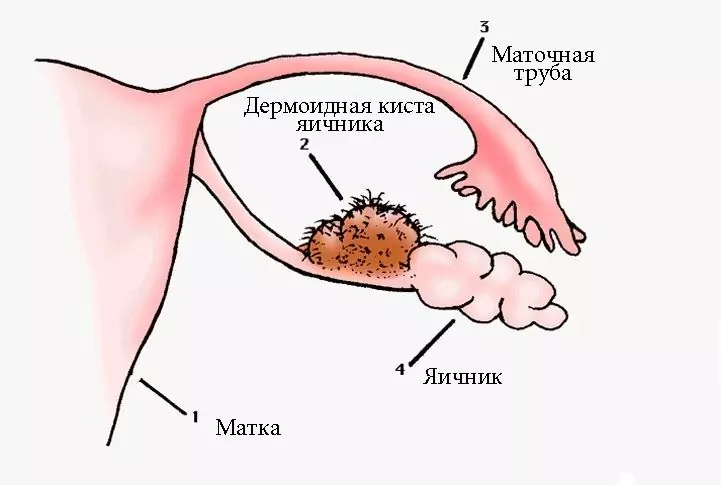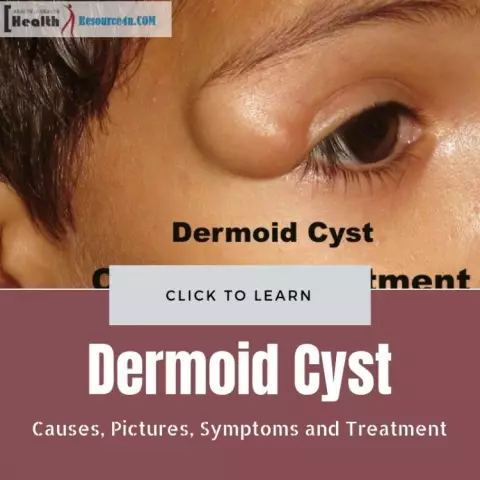- Author Rachel Wainwright [email protected].
- Public 2023-12-15 07:39.
- Last modified 2025-11-02 20:14.
Dermoid ovarian cyst
The content of the article:
- Causes of a dermoid ovarian cyst and risk factors for its development
- Dermoid ovarian cyst symptoms
- Diagnostics
- Treatment of a dermoid ovarian cyst
- Possible complications and consequences
- Forecast
A dermoid ovarian cyst is a benign formation that has developed as a result of a violation of cell division at the stage of intrauterine development.

A dermoid ovarian cyst is a benign formation, malignancy occurs in no more than 2% of cases
A dermoid ovarian cyst is usually a round or oval dense connective tissue formation lined with epithelial tissue from the inside, containing various tissues and parts of organs (teeth, hair, nails, adipose tissue, bone, cartilaginous, etc.). Due to the activity of sufficiently developed sebaceous glands inside the dermoid cyst, the accumulation of liquid contents is possible. Almost always, the formation is located on a sufficiently long leg, is mobile, not soldered to the surrounding tissues.
A similar content of the dermoid cyst is explained by its origin: as a result of embryogenesis, the remains of atypically located germ cells are preserved in the thickness of the ovary, from which an organ or tissue begins to form later (more often under the influence of provoking factors).
The content of the cyst can vary significantly, which depends on the characteristics of its constituent embryonic elements:
- ectodermal structures, represented by skin scales, elements of nervous tissue;
- in the case of a predominance of mesoderm, the dermoid ovarian cyst will be filled with fragments of connective tissue (bone, muscle, cartilaginous, adipose);
- endodermal elements are represented by glandular formations, tissue of the internal epithelium.
Basically, the contents of the ovarian dermoid cyst are made by a combination of derivatives of all 3 embryonic layers.
Ovarian neoplasms form up to ¼ of all neoplasms of the female genital area (of which about 70-80% are benign). Dermoid cysts in the structure of ovarian tumors do not occupy a leading position, the disease occurs, according to various sources, in 5-15% of patients. The dermoid cyst of the right ovary or the left is more often determined, synchronously both organs are rarely involved in the pathological process.
A dermoid cyst of the left ovary occurs several times less frequently than a neoplasm on the right. This is explained by the anatomical and physiological prevalence of the right ovary (features of blood supply and innervation, more intensive development at the stage of embryogenesis, more active ovulatory activity in the future (up to 70-80% of the total number of ovulations). The left-sided process is less intense, the size of the cyst in this case do not exceed 3-5 cm.
The disease, as a rule, begins in childhood, the clinical debut usually falls on 15-40 years. Malignancy of the dermoid cyst (usually transformation into squamous cell carcinoma) is a rare phenomenon, occurs in no more than 1.5-2% of women.
Synonyms: dermoid, mature teratoma.
Causes of a dermoid ovarian cyst and risk factors for its development
The main reason for the development of a dermoid ovarian cyst is a violation of tissue differentiation during embryogenesis, that is, intrauterine formation of fetal body structures.
The main types of aggressive influences on the forming embryonic structures that can cause the dermoid ovarian cyst:
- exposure to ionizing radiation;
- transferred viral infections;
- professional harm;
- unfavorable ecological situation;
- taking medicines during pregnancy (some antibacterial drugs, antiepileptic drugs, psychotropic drugs, drugs for the treatment of tuberculosis, etc.);
- all kinds of abuse (alcohol, illegal substances, smoking);
- hereditary predisposition;
- spontaneous genetic mutation; etc.

The main reason for the appearance of a dermoid ovarian cyst is a violation of tissue differentiation during embryogenesis
For a long time, there was a misconception that ovarian dermoid cysts can develop under the influence of hormonal influences. It has now been proven that changes in hormonal levels (puberty, pregnancy, menopause and premenopause) can be a triggering factor in the development of the disease, but not its cause.
In addition to hormonal changes, traumatic effects can be a provocateur of active growth of the dermoid ovarian cyst.
Dermoid ovarian cyst symptoms
The dermoid ovarian cyst is usually small (3-5 cm), although in some cases, formations of 10-15 cm in diameter and more are diagnosed.
Before reaching a size of 5-6 cm, symptoms of a dermoid ovarian cyst are usually absent. With a significant increase in education and compression of adjacent anatomical structures and organs, a characteristic clinical picture of the disease develops:
- aching, pulling pains in the lower abdomen, at first transient, then becoming permanent, intensifying with intense physical exertion, sudden movements, sexual intercourse;
- feeling of discomfort, pressure in the lower third of the abdomen;
- increased urination, stool retention;
- in the case of torsion of the cyst on the leg, symptoms of an acute abdomen develop (sharp unbearable pain radiating along the groin fold to the leg, perineum, a sharp increase in body temperature, chills, tachycardia, arterial hypotension).

A common symptom of a dermoid ovarian cyst is a pulling, aching pain in the lower abdomen
In some cases, a dermoid ovarian cyst can exist for a long time (sometimes for life) without causing discomfort to a woman and without affecting the quality of life, showing up by chance during an examination for another reason.
Diagnostics
Since a small dermoid ovarian cyst usually does not provoke active symptoms, its identification most often occurs in the following cases:
- gynecological examination during a preventive or dispensary examination;
- screening ultrasound examination when registering for pregnancy;
- treatment for other diseases.
In the case of large neoplasms, characteristic complaints can be suspected.

To exclude malignant transformation of the dermoid cyst, a blood test is performed for tumor markers
In order to confirm the diagnosis, the following studies are carried out:
- gynecological bimanual examination;
- ultrasound examination using transabdominal and intravaginal sensors (allows you to accurately determine the size, localization, nature of neoplasm inclusions);
- puncture of the abdominal cavity through the posterior fornix of the vagina (indicated in diagnostically unclear cases);
- diagnostics of tumor markers CA-125, CA-72.4, CA-19.9 (to exclude malignant degeneration of the dermoid ovarian cyst).
Treatment of a dermoid ovarian cyst
Treatment of a dermoid ovarian cyst is performed exclusively by surgery. Pharmacotherapy that can reduce the growth of a neoplasm or cause its involution does not exist.
The volume of surgical intervention depends on several factors: the patient's age, gynecological history, location of the neoplasm, its size, nature, and the presence of complications.
With the planned nature of the intervention, in the absence of complications and with a small size of the cyst, it is recommended to carry out an endoscopic operation (laparoscopy), with the preservation of the ovary after removal of the mass formation (cystectomy within healthy ovarian tissues). In this case, the reproductive function is restored within six months, after which, if necessary, the patient can plan a pregnancy.

Treatment of a dermoid ovarian cyst is only surgical. The method and scope of intervention depends on the size of education and the woman's age
With an average size of the dermoid cyst, a wedge-shaped resection (removal) of the interested part of the ovary is shown. In this case, pregnancy planning is possible no earlier than a year after the intervention.
With a large size of the formation, torsion of the cyst, its rupture, the presence of other complications, the removal of the entire involved ovary is indicated. Total oophorectomy is also indicated for patients in the premenopausal period or in menopause, when the risk of malignancy of benign formations significantly increases.
In some cases, if the cyst capsule is not completely removed, the disease may recur, although this condition is rare.
Possible complications and consequences
Complications of a dermoid ovarian cyst can be:
- torsion of the cyst on the pedicle;
- rupture of the cyst;
- ovarian atrophy;
- malignant degeneration of the cyst;
- suppuration of the cyst.
Forecast
With timely diagnosis and treatment, the prognosis is favorable.
YouTube video related to the article:

Olesya Smolnyakova Therapy, clinical pharmacology and pharmacotherapy About the author
Education: higher, 2004 (GOU VPO "Kursk State Medical University"), specialty "General Medicine", qualification "Doctor". 2008-2012 - Postgraduate student of the Department of Clinical Pharmacology, KSMU, Candidate of Medical Sciences (2013, specialty "Pharmacology, Clinical Pharmacology"). 2014-2015 - professional retraining, specialty "Management in education", FSBEI HPE "KSU".
The information is generalized and provided for informational purposes only. At the first sign of illness, see your doctor. Self-medication is hazardous to health!






